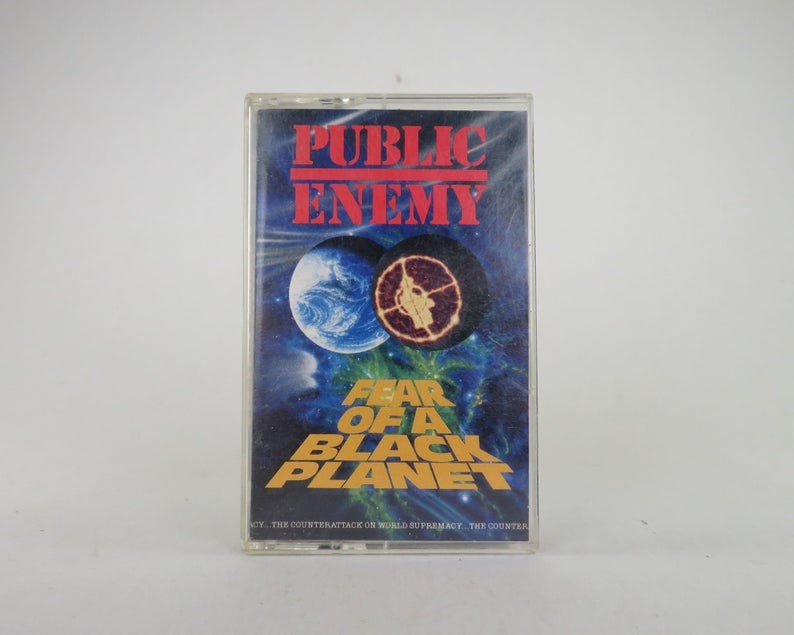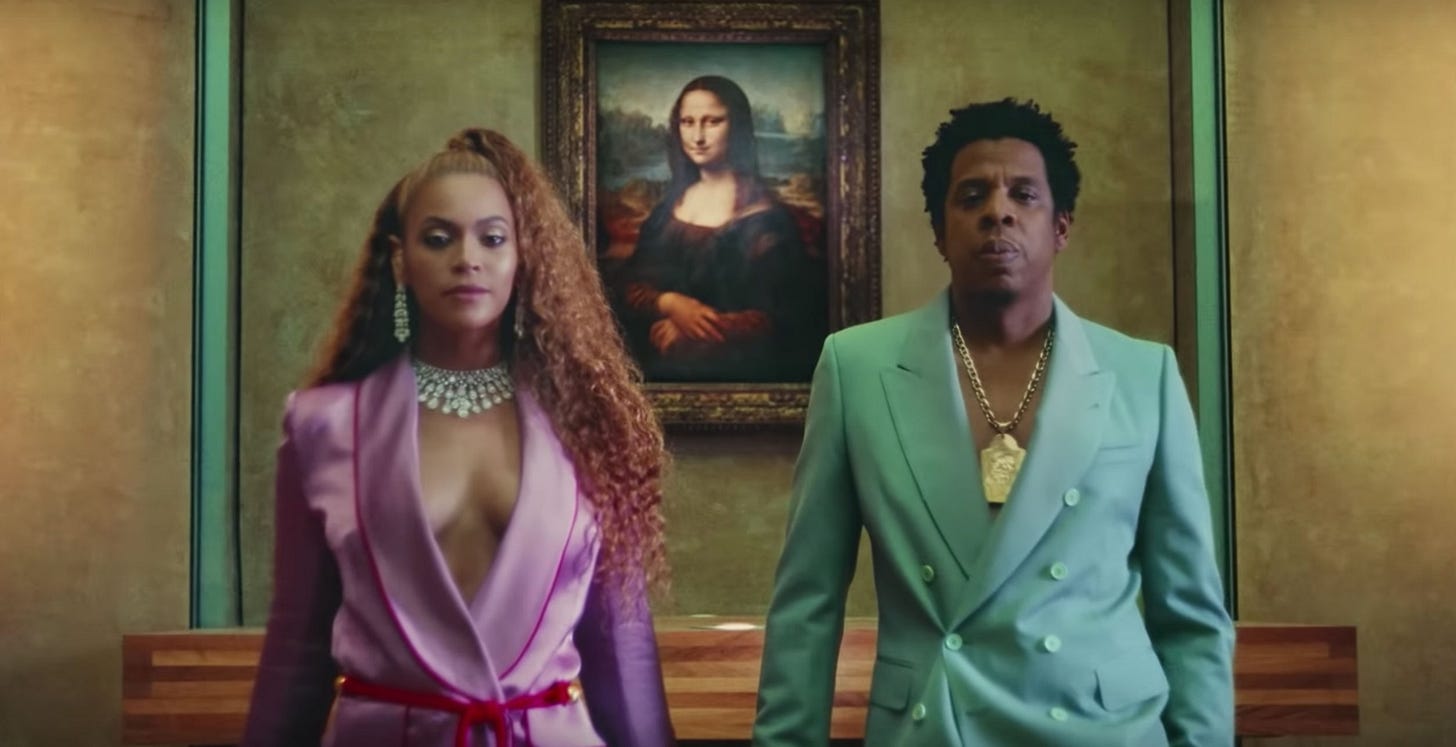The 2020 Crisis Series. 2020 has served as a breaking point for so many structures in health, justice, economy, and equality. I explore how individuals and companies can find lessons out of this year’s challenges to create a better world. Sign up for more here.
Fear of a Black Planet.
When I was a kid, we had a thing called Columbia House Records, where you would subscribe to get 13 albums on cassette tape for a penny. Every month my box of tapes would come and I would tear into them, unsheathing each from a plastic wrapper and popping it into my bedroom boom box to listen.

You can still buy cassettes on Etsy!
This is how I discovered Public Enemy. I ordered Fear of a Black Planet, and it arrived on our little sheep farm in super-white rural Michigan with a message from another world. I bought it be tough and listen to rap and pretend I lived in a big city, but what I really got was an education in Black anger, Black history, and Black protest. It introduced me to the lives of men who see Elvis not as a hero of Americana, but as an appropriator of Black musical heritage, and who experience police as negligent and violent, not as helpful institutions. The fact that Fear of Black Planet made it up the ranks of the music industry, onto that Columbia House catalog, and into my tween ears still amazes me.
And yet, for decades the words of our most eloquent and activist Black rappers, comedians, and other artists have not ignited the kind of cultural transformation we’ve seen over the last month. In the MeToo moment, women in the whisper networks finally got the microphone. For Black Lives Matter, people who have had the mic are finally getting heard.
Today’s Protest Tunes.
When I tuned in to this past week’s new music selection on iTunes, I was shook. I usually get served up frothy hip hop and dance music, but the the state of the world had crashed the party of iTunes recommendation algorithm. Of the first 15 songs on the list, at least six were overtly about protest:
Public Enemy is back! And rapping about ‘fear of the combover.’
Anderson.Paak served up a gorgeous, angry, graceful protest song that had me crying.
Amber Mark with a spiritual call to hold on, in a cover of Eddie Kendricks’ My People.
Noname with a short flow about the death of Black women, in response to a J Cole track that seemed to ask her to calm down.
Wale used samples of the protests in a single about the movement from his new EP.
H.E.R. with a new song titled simply I Can’t Breathe.

I am used to hearing anger at injustice from rappers like Kendrick, Killer Mike, and J Cole. They have kept the moral compass of rap while many of their peers rap about spectacular amounts of money and fame. But the glorification of consumption is also a political act, as Tressie McMillan Cottom writes in her book Thick and Other Essays. She posits that, to succeed as a person clawing out of poverty, success signals are a survival tactic, not an indulgence. To be seen as a person who has nice clothing is a pathway to respectability. Rap culture has taken that to the next level, signalling new money as a means to belonging in the upper echelons of society. Rappers stake claim in a culture that has not recognized their wealth or power as legitimate—conspicuous consumption as a form of resistance. In the ultimate flex, Beyoncé and Jay Z closed down the Louvre for the Ape Shit video, putting Black creativity and wealth in the most venerated temple to high culture.

High art: Bey & Jay & Mona Lisa
Protest Music Past.
It’s been a long time since we’ve seen protest music whose intent is not to rage or flex, but to gather and encourage, to bear witness to a movement and to fight. A VOX primer on protest music defines it this way:
These songs are usually written to be part of a movement for cultural or political change, and to galvanize that movement by drawing people together and inspiring them to take action or reflect.
Protest songs often skew liberal, and usually fall under two major categories: politically charged, topical songs taking issue with the government, or culturally focused songs aimed at injustices facing marginalized groups.
The article lists several movements in protest music since the Revolutionary War in the US, when Yankee Doodle Dandy was sung by British soldiers to insult the new Americans, and then was co-opted by the Americans. Unsurprisingly, much of the history of protest music has been led by Black America during slavery, in the Civil Rights movement, and into today. And so much of American culture, especially musically, is born of Black culture.

This chart of white and Black music cultures made the rounds on Instagram, original source unknown.
Now music is turning to protest. Even in classical music, inherently conservative (with a lower case c), notoriously white and ‘apolitical’ (with air quotes, because choosing not to be political right now is a political choice), there is a touchstone of protest music.
But protest seeping into pop culture is just the beginning. The music industry has been grappling with its own inequalities; Black anger has been a moneymaker for so long, and now, that anger is pushing over power structures. It was two Black women from the music industry that kick started the Blackout Tuesday hashtag. In sports, the NFL has promised to play Lift Every Voice and Sing, also known as the Black anthem, before every Week 1 game, a move that isn’t address the real issues in the organization, as pointed out by NFL player Donté Stallworth among others.
Protest Culture in the Ad World.
The last time protest was in our zeitgeist at this level, BLM protests raged in Fergislm Pepsi aired its notorious Kendall Jenner ad, put together by an all-white creative team and unabashedly borrowing from Black Lives Matter protests and aesthetics. Miriam Bale breaks it down well:
And so, in a way, Pepsi did inadvertently sum up the zeitgeist of America in the last few years: white media and corporations scrambling to steal from black creators on social networks (which benefit Silicon Valley corporations, not these creators). Phrases like "on fleek" and "yas" find their way into advertisements for plastic cups or Hillary Clinton while the originators of the phrases don’t see a cent. When will companies like these learn to employ black people in top positions, as McCann Erickson did when it hired Billy Davis [of I’d like to Buy the World A Coke fame] away from a soul songwriting career, or collaborate with black artists to create something new, instead of repurposing or brazenly stealing from black culture?
Cultural fluency is key to innovation and relevance, and culture is shifting to make room for previously unheard voices. Yet companies continue to hire and promote people who don’t live at the heart of cultural transformation, and have even been hostile to learning about it.
Diversity is not only about representation; it’s about including and incorporating diverse perspectives shaped by different cultures. What can someone bring to the table that offers a a point of view not held by the majority? How can we elevate the voices that challenge the dominant world view and envision a different way of being? How do we support, promote, and pay people accordingly?
Acknowledging protest is to act quickly and decisively in support, and to create change in your company, your industry, and your output. Start by hiring, mentoring, and building company cultures that encourage and support voices of people of color. When companies don’t create change, the people most affected will create change for them, like in the recent walk-out at the Periscope agency in Minneapolis.
Here are a few tools for the advertising and creative industries.
Hiring Employees, Freelancers, and Vendors
There’s 0 excuses for not being able to find a person of color for a role anymore. In the wake of the Black Lives Matter movement, countless lists have emerged for jobs and talent. Here’s a few on my radar:
A post from Why Is This Interesting that lists talent hubs, Black creative talent, and Black-owned agencies.
TheCrtvCo is a job and talent pool for people of color.
The Underrepresented List is a straight up Google Sheets database of people of color across roles and markets.
Blacks Who Design is a sortable list of Black designers.
Hire Black Female Creatives is an endless scroll list of creatives, from art direction to nail art.
28 Black Designers highlights a designer every day of Black History Month.
Mentoring and Sponsoring.
In every industry, people need support from those with more experience and seniority. When an person is underrepresented in an industry, it’s even more important to have that support. Mentorship from a person who understands the struggles of being underrepresented is key to navigating corporate minefields, and having someone in the dominant culture as a champion also drives success. Here are a few resources to start:
One of my favorite creators and collaborators, Shannon Washington, has built a community for Black women creatives, now open for mentorship from anyone who knows the ad/marketing/creative game.
Women Who Create is a longer term mentoring program for women of color .
Marcus Graham Project mentors and helps young Black talent in the marketing industry.
Building Culture.
Hiring is great, but so many people of color (me included) have found inhospitable environments in agencies. People of color often find themselves being the lone dissenting voice in a room full of people who know very little beyond their own dominant culture. This tweet sums it up.

But transforming company culture shouldn’t fall solely on the shoulders of people of color.
Internal cultures need to create supportive environments. Six hundred Black ad professionals have made a list of demands from agencies, specifically outlining what they can do better.
For guidance on building a supportive, equity-led culture, I turn to nonprofits, who have spent decades assessing how to best match their culture to their mission. This guidebook from the LA County Arts and Culture Department is a helpful primer, but it’s just the start.
2020 has served as a breaking point for so many structures in health, justice, economy, and equality. I explore how individuals and companies can find lessons out of this year’s challenges to create a better world. Sign up for more.
If you or your brand need help with how you show up in this new world, Frame Strategy is now available for brand strategy and communications consulting. Let’s connect.



